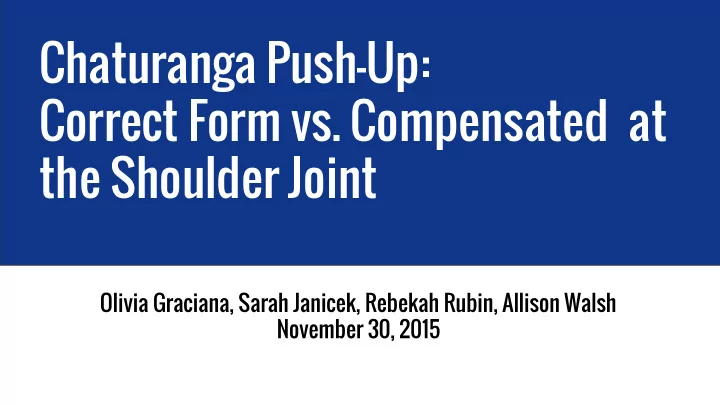

Chaturanga Push-Up: Correct Form vs. Compensated at the Shoulder Joint Olivia Graciana, Sarah Janicek, Rebekah Rubin, Allison Walsh November 30, 2015
How to Perform a Chaturanga Series
Chaturanga Push-up: Correct Form
Chaturanga Push-up: Compensated Used due to lack of strength in the core and/or back musculature ❖ Shoulders roll forward, pelvis is lifted, elbows are directed more laterally ❖
Main Joints Involved: Muscles Involved: During the correct push-up: ❖ Glenohumeral - neutral ➢ Elbow - flexion at 90° ➢ Wrist - extension and pronation ➢ During the compensated push-up: ❖ Glenohumeral - extension/IR ➢ Elbow - flexion > 90° ➢ Wrist - extension and pronation ➢
Muscles Involved: Muscles Involved: Primary: Triceps , Biceps Femoris, Rectus Femoris, Pectoralis Major, Deltoids ❖ Secondary: Pectoralis Minor, Latissimus Dorsi, Rectus Abdominis, Oblique ❖ Abdominis, Iliopsoas
The Risk of Chaturanga: Muscles Involved: ❖ Shoulder injuries 2nd most common yoga injury, secondary to neck/cervical ❖ Chaturanga Push-Up movement most commonly sited motion for injury to the shoulder in yoga due to excessive loads and poor form
Part I: Calculate the Center of Mass for ❖ both the correct and compensated Experimental chaturanga push-up position Part II: Design Determine the percentage of body ❖ weight distributed to the upper vs. lower extremity during the push-up position
Part I: Methods Muscles Involved: ❖ Data collected using iPhone 5s camera at 10 frames/second ❖ Marker Placement: 1) Lateral Malleolus, 2) Fibular Head, 3) Greater Trochanter, 4) Lateral Aspect of Acromion, 5) Lateral Epicondyle, 6) Ulnar Styloid ❖ Frame of motion analyzed at lowest point of movement during Center of Mass calculations (Segmental Method)
Part I: Methods Muscles Involved: Data from Winter (1990) was used during calculations and analysis
Correct Position: Analysis Uncompensated Chaturanga Push-Up Position The Center of Mass for each ❖ segment was determined using the segmental method and data from Winter (1990) Segments: ❖ Forearm and Hand ➢ Arm ➢ Leg and Foot ➢ Thigh ➢ Trunk, head and neck ➢
Correct Position: Analysis Uncompensated Chaturanga Push-Up Position Segmental Method for finding the ❖ Center of Mass Data from Winter (1990) ❖
Correct Position: Analysis Uncompensated Chaturanga Push-Up Position Segmental Method for finding the ❖ Center of Mass Data from Winter (1990) ❖
Correct Position: Analysis Uncompensated Chaturanga Push-Up Position The Center of Mass is 40.36 cm ❖ perpendicular from the lateral acromion
Compensated Position: Analysis Uncompensated Chaturanga Push-Up Position The Center of Mass for each ❖ segment was determined using data from Winter (1990) Segments: ❖ Forearm and Hand ➢ Arm ➢ Leg and Foot ➢ Thigh ➢ Trunk, head and neck ➢
Compensated Position: Analysis Uncompensated Chaturanga Push-Up Position Segmental Method for finding the ❖ Center of Mass Data from Winter (1990) ❖
Compensated Position: Analysis Uncompensated Chaturanga Push-Up Position Segmental Method for finding the ❖ Center of Mass Data from Winter (1990) ❖
Compensated Position: Analysis Uncompensated Chaturanga Push-Up Position The Center of Mass is 36.40 cm ❖ perpendicular from the lateral acromion
Part I: Results Results Correct Compensated 40.36 cm 36.40 cm Perpendicular Distance from Lateral Acromion to Center of Mass
Part II: Methods Muscles Involved: ❖ Data collected using an analog scale ❖ Weight under hands at lowest point of motion used for weight distribution analysis
Part II: Results Results Correct Compensated 74 % : 26 % 79 % : 21 % Percentage of Body Weight through the Upper Extremity & Lower Extremity
Conclusions Conclusions Muscles Involved: Based on the distal shift of the C.O.M and the distribution of body weight ❖ being less in upper extremity during the correct position, we conclude: the correct position places less weight/load through the shoulder joint ➢ the compensated position creates more load on the shoulder joint, ➢ potentially resulting in forces that could damage the joint structures individuals should be trained to properly perform the chaturanga ➢ push-up position to reduce risk of injury at the shoulder joint
Effects on Treatment Conclusions Muscles Involved: When treating a patient with an upper extremity injury who frequently ❖ partakes in yoga: correct, if necessary, the common reasons why individuals use the ➢ compensated chaturanga pushup position strengthen the core & scapular stabilizing muscles ■ stretch the chest muscles (specifically pectoralis muscles) ■ train the correct form of the chaturanga pushup - reduce overreliance ➢ on arm and chest musculature (eg: triceps, biceps, pecs)
Errors Experimental Errors / Assumptions Movement of markers on clothing ❖ Degree of accuracy of measurements when calculating C.O.M ❖ Manual placement of marker ❖ Velocity and Acceleration are held constant ❖ The bottom of the motion is the most stressful on the shoulder joint ❖
References References Benitez, D. (2001). Drop and give me 10. Yoga Journal. Retrieved from https://books.google.com/books?id=PuoDAAAAMBAJ&lpg=RA1-PA85&ots=suAeeXRf56&dq=chaturanga%20compensation&pg=RA1-PA85#v=onepage&q=chaturanga%20c ompensation&f=false Cole, R. (2007). The Perfect Chaturanga Counterpose: Upward Plank Pose (Purvottanasana). Yoga Journal. Retrieved from http://www.yogajournal.com/article/practice-section/the-anti-chaturanga-dandasana-2/ Ni, M., Mooney, K., Balachandran, A., Richards, L., Harriell, K., & Signorile, J. F. (2014). Muscle utilization patterns vary by skill levels of the practitioners across specific yoga poses (asanas). Complementary therapies in medicine , 22 (4), 662-669. Raub, J. A. (2002). Psychophysiologic effects of Hatha Yoga on musculoskeletal and cardiopulmonary function: a literature review. The Journal of Alternative & Complementary Medicine , 8 (6), 797-812. Wilcox, S. J. (2010). Ground reaction forces generated by twenty-eight common Hatha yoga postures. Retrieved from http://scholarsarchive.byu.edu/cgi/viewcontent.cgi?article=3305&context=etd Winter, D.A. (1990) Biomechanics and Motor Control of Human Movement, 2nd e.d., Toronto: John Wiley & Sons
Questions?
Recommend
More recommend